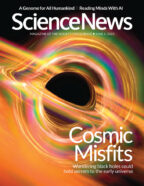This post was originally published on this site
Magnetic muck-ups
A study of fragments from a Martian meteorite shows that the common practice of using magnets to identify meteorites can overwrite records of magnetic fields stored within the space rocks, Katherine Kornei reported in “Searching for meteorites? Ditch the magnets” (SN: 6/3/23, p. 5).
Reader C. R. Prahl asked how scientists can know precisely a meteorite’s source.
Scientists can determine a meteorite’s origins by looking at the space rock’s chemical makeup, Kornei says. As rocks form, tiny air bubbles often get trapped within them. Those air pockets sometimes chemically look nothing like Earth’s atmosphere. For example, the chemical composition of the air pockets in the meteorite fragments used in this study was a great match for Mars’ atmosphere. That’s good evidence that the rocks originally formed on Mars, Kornei says.
Prahl also wondered whether the magnetic field records of the Martian meteorite could have been wiped instead by Earth’s magnetic field as the rock entered the atmosphere.
Earth’s magnetic field does rearrange the spins of electrons in a meteorite. But only a small fraction of those electrons are typically affected, Kornei says. That’s because Earth’s magnetic field is relatively weak. Magnets, however, typically produce much stronger magnetic fields that can rearrange the spins of most of the electrons within a meteorite. By studying a meteorite’s magnetic properties, researchers can tell the difference between a meteorite that’s simply been sitting on Earth’s surface and one that’s been exposed to a magnet, Kornei says.
Screwworm story time
In the 1970s, a “fly factory” that produced sterile screwworm flies was built to eradicate screwworms, a major livestock pest. Such efforts have helped North and Central America keep screwworms in check for decades, Nikk Ogasa reported in an update to the 1973 Science News article “Fly factory planned” (SN: 6/3/23, p. 4).
Reader Howard Schneeberger reminisced about playing a part in the screwworm eradication efforts 50 years ago. As the captain of a cargo plane, Schneeberger delivered sterile screwworm fly larvae to Puerto Rico. “The trip was timed so the larvae would hatch on our arrival,” Schneeberger wrote.
“Each small cardboard box was about the size of a takeout hamburger box and had a cup of coagulated blood in the center surrounded by hundreds of maggots,” Schneeberger recounted. “We had to keep the cargo compartment full cold to prevent them from hatching en route. Needless to say, many … did hatch and we were grateful to arrive in San Juan.” Upon touching down in Puerto Rico, the boxes of sterile larvae were transferred to helicopters and dumped throughout the countryside, Schneeberger wrote.
In the brain
In a clinical trial, microscopic bubbles and ultrasound waves opened the nearly impenetrable blood-brain barrier to help deliver a powerful chemotherapy drug directly into the brain. The method could lead to new treatments for people with brain cancer, McKenzie Prillaman reported in “Ultrasound lets chemo into the brain” (SN: 6/3/23, p. 10).
Reader Phil Chubb asked if the method could help treat other brain diseases.
Researchers are looking into that question now, Prillaman says. Indeed, scientists are investigating whether the method could be used to deliver drugs in people with neurodegenerative diseases, including Alzheimer’s and Parkinson’s.
Clarification
“The original highfliers” stated that more than 75 percent of all life on Earth was extinguished by the asteroid that killed the dinosaurs (SN: 5/6/23 & 5/20/23, p. 26). It would have been clearer to say that more than 75 percent of species were extinguished.
Correction
“Oddball black holes” incorrectly stated that dwarf galaxies are about a trillionth the mass of the Milky Way (SN: 6/3/23, p. 24). Dwarf galaxies are about a hundred-thousandth to a millionth the mass of the Milky Way.

